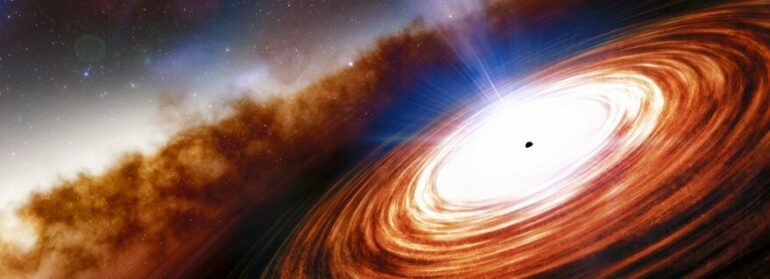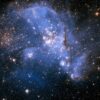Astronomers from Leiden Observatory have developed a new method to find distant quasars and better distinguish them from other objects that look like them, using machine learning techniques. The research result has been accepted for publication in the journal Astronomy & Astrophysics. It is the last article to be co-authored with Maolin Zhang, the promising Leiden Ph.D. student of Chinese origin who died in a fire at his home in 2019.
A quasar is an extremely bright active center of a galaxy, powered by a supermassive black hole that can be up to a billion times heavier than the sun. Some supermassive black holes in the centers of galaxies are inactive, like the black hole in our Milky Way, but many are active, surrounded by a swirling disk of superheated gas.
The most powerful particle accelerators in the universe
The black holes launch jets that reach hundreds of thousands of light-years into intergalactic space. They accelerate charged particles at speeds close to the speed of light, making them among the most powerful particle accelerators in the universe. Gas ejection by jets is essential for regulating mass and star formation in some of the most massive galaxies, so supermassive black holes play an important role in the formation and evolution of galaxies.
Seek the differences: Quasar or red dwarf
Quasars are therefore ideal objects for studying the evolution of the universe, especially its earliest stages. One of the biggest challenges facing astronomers is finding these objects. Because they are so far away, quasars are seen as faint red dots in the sky. Ironically, from Earth these powerhouses at the ‘edge’ of the universe look very similar to objects like red dwarfs, stars smaller than our Sun that astronomers can only observe within a few hundred light years. Because there are so many more dwarf stars than quasars, most samples of promising quasar candidates have traditionally been heavily contaminated with dwarf stars.
The astronomers unleashed the new method on a catalog of sources from the large sky survey of Pan-STARRS, a set of optical telescopes in Hawaii, supported by a catalog of radio sources from LOFAR, ASTRON’s low-frequency radio telescope in the Netherlands. Using the combined data, they have identified sources that are most likely quasars. To properly identify these objects, they measured the spectra of a small number of candidates with the 2-meter Isaac Newton Telescope on La Palma.
New detection technique is a break-through
The study confirmed that one of the candidates was indeed a very bright quasar, from the time the Universe was less than a billion years old. The discovery of this never-before-seen quasar shows that the developed technique opens up new ways to discover more quasars in the early Universe, both in existing and future surveys. The researchers expect that hundreds of other quasars could be hidden, as the newly discovered quasar was found in a relatively small area of the sky.
Homage to departed author
Co-author of this article is Leiden Ph.D. student Maolin Zhang. During a fire in his house in Hillegom in the early morning of 17 January 2019, Zhang died. His career in astronomy thus came to an early end. Zhang grew up in China. He was from a humble background but managed to get admitted to the prestigious Tsinghua University, where he obtained a master’s degree in Engineering in 2016.
In 2017, he received a joint scholarship from the China Scholarship Council (CSC) and Leiden University for a Ph.D. degree in astronomy. Because of his exceptional achievements, he was considered a hero in the local community in China where he grew up and where his parents still live. First author and Ph.D. student Jonah Wagenveld and Maolin Zhang collaborated in this research on the new detection method for quasars.
More information:
J. D. Wagenveld, A. Saxena, K. J. Duncan, H. J. A. Röttgering, M. Zhang, Revealing new high redshift quasar populations through Gaussian mixture model selection. arXiv:2201.11724v1 [astro-ph.GA], arxiv.org/abs/2201.11724
Citation:
New detection method for quasars in the early universe (2022, February 10)



